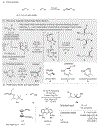Aliphatic Radical Relay Heck Reaction at Unactivated C(sp3 )-H Sites of Alcohols
- PMID: 30462879
- PMCID: PMC6359925
- DOI: 10.1002/anie.201812398
Aliphatic Radical Relay Heck Reaction at Unactivated C(sp3 )-H Sites of Alcohols
Abstract
The Mizoroki-Heck reaction is one of the most efficient methods for alkenylation of aryl, vinyl, and alkyl halides. Given its innate nature, this protocol requires the employment of compounds possessing a halogen atom at the site of functionalization. However, the accessibility of organic molecules possessing a halogen atom at a particular site in aliphatic systems is extremely limited. Thus, a protocol that allows a Heck reaction to occur at a specific nonfunctionalized C(sp3 )-H site is desirable. Reported here is a radical relay Heck reaction which allows selective remote alkenylation of aliphatic alcohols at unactivated β-, γ-, and δ-C(sp3 )-H sites. The use of an easily installed/removed Si-based auxiliary enables selective I-atom/radical translocation events at remote C-H sites followed by the Heck reaction. Notably, the reaction proceeds smoothly under mild visible-light-mediated conditions at room temperature, producing highly modifiable and valuable alkenol products from readily available alcohols feedstocks.
Keywords: C−H activation; Heck reaction; palladium; photochemistry; radicals.
© 2019 Wiley-VCH Verlag GmbH & Co. KGaA, Weinheim.
Conflict of interest statement
Conflict of interest
The authors declare no conflict of interest.
Figures




Similar articles
-
Electrophotochemical Radical Relay for Remote Alkenylation of Unactivated C(sp3)-H Sites in Alcohols.Angew Chem Int Ed Engl. 2025 Aug 4;64(32):e202508960. doi: 10.1002/anie.202508960. Epub 2025 Jun 3. Angew Chem Int Ed Engl. 2025. PMID: 40436815
-
General, Auxiliary-Enabled Photoinduced Pd-Catalyzed Remote Desaturation of Aliphatic Alcohols.J Am Chem Soc. 2017 Oct 25;139(42):14857-14860. doi: 10.1021/jacs.7b08459. Epub 2017 Oct 12. J Am Chem Soc. 2017. PMID: 28992686 Free PMC article.
-
Transition-Metal- and Light-Free Directed Amination of Remote Unactivated C(sp3)-H Bonds of Alcohols.J Am Chem Soc. 2019 May 22;141(20):8104-8109. doi: 10.1021/jacs.9b04189. Epub 2019 May 8. J Am Chem Soc. 2019. PMID: 31046256 Free PMC article.
-
From α-arylation of olefins to acylation with aldehydes: a journey in regiocontrol of the Heck reaction.Acc Chem Res. 2011 Aug 16;44(8):614-26. doi: 10.1021/ar200053d. Epub 2011 May 25. Acc Chem Res. 2011. PMID: 21612205 Review.
-
Olefinic C-H functionalization through radical alkenylation.Chem Soc Rev. 2015 Mar 7;44(5):1070-82. doi: 10.1039/c4cs00347k. Chem Soc Rev. 2015. PMID: 25553785 Review.
Cited by
-
General and Selective Metal-Free Radical α-C-H Borylation of Aliphatic Amines.Chem. 2022 Nov;8(11):3096-3108. doi: 10.1016/j.chempr.2022.07.022. Epub 2022 Aug 22. Chem. 2022. PMID: 36571075 Free PMC article.
-
Photoinduced Palladium-Catalyzed Carbofunctionalization of Conjugated Dienes Proceeding via Radical-Polar Crossover Scenario: 1,2-Aminoalkylation and Beyond.J Am Chem Soc. 2020 Jun 3;142(22):9932-9937. doi: 10.1021/jacs.0c03993. Epub 2020 May 19. J Am Chem Soc. 2020. PMID: 32406231 Free PMC article.
-
Excited-State Palladium-Catalyzed Radical Migratory Mizoroki-Heck Reaction Enables C2-Alkenylation of Carbohydrates.J Am Chem Soc. 2022 Mar 2;144(8):3353-3359. doi: 10.1021/jacs.1c13299. Epub 2022 Feb 21. J Am Chem Soc. 2022. PMID: 35188768 Free PMC article.
-
Sulfamyl Radicals Direct Photoredox-Mediated Giese Reactions at Unactivated C(3)-H Bonds.Org Lett. 2019 Aug 2;21(15):6089-6095. doi: 10.1021/acs.orglett.9b02234. Epub 2019 Jul 17. Org Lett. 2019. PMID: 31313933 Free PMC article.
-
Single-Electron-Transfer-Mediated Carbonylation Reactions.Acc Chem Res. 2025 Mar 18;58(6):1036-1050. doi: 10.1021/acs.accounts.5c00039. Epub 2025 Mar 5. Acc Chem Res. 2025. PMID: 40042084 Free PMC article.
References
-
- Ma W, Gandeepan P, Li J, Ackermann L, Org. Chem. Front 2017, 4, 1435–1467.
-
- He J, Li S, Deng Y, Fu H, Laforteza BN, Spangler JE, Homs A, Yu J-Q, Science 2014, 343, 1216–1220; - PMC - PubMed
- Jiang H, He J, Liu T, Yu J-Q, J. Am. Chem. Soc 2016, 138, 2055–2059; - PMC - PubMed
- Stowers KJ, Fortner KC, Sanford MS, J. Am. Chem. Soc 2011, 133, 6541–6544; - PMC - PubMed
- He C, Gaunt MJ, Chem. Sci 2017, 8, 3586–3592; - PMC - PubMed
- Zhuang Z, Yu C-B, Chen G, Wu Q-F, Hsiao Y, Joe CL, Qiao JX, Poss MA, Yu J-Q, J. Am. Chem. Soc 2018, 140, 10363–10367. - PMC - PubMed
-
-
See Ref. [3b] and:
- Thrimurtulu N, Khan S, Maity S, Volla CMR, Maiti D, Chem. Commun 2017, 53, 12457–12460. - PubMed
-
-
- Oestreich M, The Mizoroki – Heck Reaction, Wiley, Chichester, 2009;
- Beletskaya IP, Cheprakov AV, Chem. Rev 2000, 100, 3009–3066. - PubMed
Publication types
MeSH terms
Substances
Grants and funding
LinkOut - more resources
Full Text Sources

